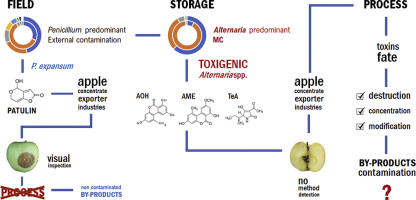当前位置:
X-MOL 学术
›
Int. J. Food Microbiol.
›
论文详情
Our official English website, www.x-mol.net, welcomes your
feedback! (Note: you will need to create a separate account there.)
From field to process: How storage selects toxigenic Alternaria spp. causing mouldy core in Red Delicious apples.
International Journal of Food Microbiology ( IF 5.0 ) Pub Date : 2020-03-02 , DOI: 10.1016/j.ijfoodmicro.2020.108575 María Agustina Pavicich 1 , Paola Cárdenas 2 , Graciela Noemí Pose 3 , Virginia Fernández Pinto 1 , Andrea Patriarca 1
International Journal of Food Microbiology ( IF 5.0 ) Pub Date : 2020-03-02 , DOI: 10.1016/j.ijfoodmicro.2020.108575 María Agustina Pavicich 1 , Paola Cárdenas 2 , Graciela Noemí Pose 3 , Virginia Fernández Pinto 1 , Andrea Patriarca 1
Affiliation

|
Apple is a major crop in Argentina where 50% of the production is derived to by-products. Industries process either recently harvested apples or fruit stored for up to 9 months. This crop is susceptible to fungal diseases both external and internal, such as mouldy core (MC). The incidence of fungal pathogens changes during storage, as well as the risk associated with their presence since some contaminants belong to mycotoxigenic genera. The objective of this study was to characterize the fungal contaminants of Red Delicious apple fruit in Argentina evaluating their evolvement from field to process, with main interest on MC causal agents and mycotoxigenic species. A total of 240 apples were analysed; 140, recently harvested and intended for fresh consumption (C), and 100 stored for 9 months in a refrigerated chamber (0-3 °C) and destined to industrialization (I). The 86% of fresh consumption apples showed external fungal lesions, and only 14% were undamaged; MC incidence was 34%. High biodiversity was observed; Penicillium was the predominant genus (54%), followed by Alternaria spp. (41%). Only 3% of industrialization fruit were undamaged, 48% had external lesions and 51% MC. However, biodiversity was lower in these apples. Alternaria spp. was recovered from 60% of apples, mainly causing MC, while Penicillium spp. took second place (34%). All the Alternaria isolates belonged to Section Alternaria with A. tenuissima as the predominant species-group. Alternariol was synthesised by 75% of the isolates, while both alternariol monomethyl-ether and tenuazonic acid by 76%. From the 100 I apples, 93 were contaminated with at least one of these mycotoxins. Alternaria was the main causal agent of MC in Argentinean Red Delicious apples, and fruit affected by this disease might be incorporated into the process line, with a consequent risk of mycotoxin contamination in apple by-products.
中文翻译:

从田间到过程:储存如何选择产毒链格孢菌。导致红色美味苹果发霉。
苹果是阿根廷的主要农作物,其产量的50%来自副产品。工业界要么加工最近收获的苹果,要么加工长达9个月的水果。这种作物易受内在和内在的真菌病害,例如发霉的核心病(MC)。真菌病原体的发生在存储过程中会发生变化,并伴随着它们的存在而发生变化,因为某些污染物属于霉菌毒素属。这项研究的目的是鉴定阿根廷红色美味苹果果实的真菌污染物,评估其从田间到加工的演变过程,主要关注MC病原体和致毒毒素物种。总共分析了240个苹果。140,最近收获并打算用于新鲜消费(C),100份在冷藏室(0-3°C)中保存9个月,准备工业化(I)。新鲜食用的苹果中有86%表现出外部真菌损害,只有14%未被破坏。MC发生率为34%。观察到生物多样性高;青霉菌是最主要的菌种(54%),其次是链格孢菌。(41%)。只有3%的工业化水果未受损,48%的外部损伤和51%的MC。但是,这些苹果的生物多样性较低。链格孢属 从60%的苹果中回收,主要是引起MC,而青霉属。位居第二(34%)。所有的链格孢属分离物均属于链格孢属部分,其中tenuissima为主要种。75%的分离物合成了交替烯丙醇,而交替异构体的单甲基醚和替纳唑酸均合成了76%。从我的100个苹果中 其中93种被至少一种霉菌毒素污染。交链孢菌是阿根廷红色美味苹果中MC的主要病原体,受此病影响的水果可能被纳入生产线,因此苹果副产品中有霉菌毒素污染的风险。
更新日期:2020-03-02
中文翻译:

从田间到过程:储存如何选择产毒链格孢菌。导致红色美味苹果发霉。
苹果是阿根廷的主要农作物,其产量的50%来自副产品。工业界要么加工最近收获的苹果,要么加工长达9个月的水果。这种作物易受内在和内在的真菌病害,例如发霉的核心病(MC)。真菌病原体的发生在存储过程中会发生变化,并伴随着它们的存在而发生变化,因为某些污染物属于霉菌毒素属。这项研究的目的是鉴定阿根廷红色美味苹果果实的真菌污染物,评估其从田间到加工的演变过程,主要关注MC病原体和致毒毒素物种。总共分析了240个苹果。140,最近收获并打算用于新鲜消费(C),100份在冷藏室(0-3°C)中保存9个月,准备工业化(I)。新鲜食用的苹果中有86%表现出外部真菌损害,只有14%未被破坏。MC发生率为34%。观察到生物多样性高;青霉菌是最主要的菌种(54%),其次是链格孢菌。(41%)。只有3%的工业化水果未受损,48%的外部损伤和51%的MC。但是,这些苹果的生物多样性较低。链格孢属 从60%的苹果中回收,主要是引起MC,而青霉属。位居第二(34%)。所有的链格孢属分离物均属于链格孢属部分,其中tenuissima为主要种。75%的分离物合成了交替烯丙醇,而交替异构体的单甲基醚和替纳唑酸均合成了76%。从我的100个苹果中 其中93种被至少一种霉菌毒素污染。交链孢菌是阿根廷红色美味苹果中MC的主要病原体,受此病影响的水果可能被纳入生产线,因此苹果副产品中有霉菌毒素污染的风险。











































 京公网安备 11010802027423号
京公网安备 11010802027423号